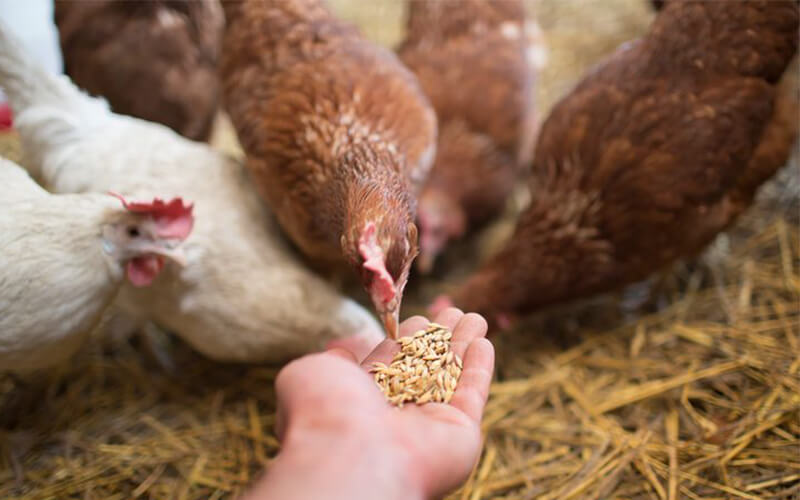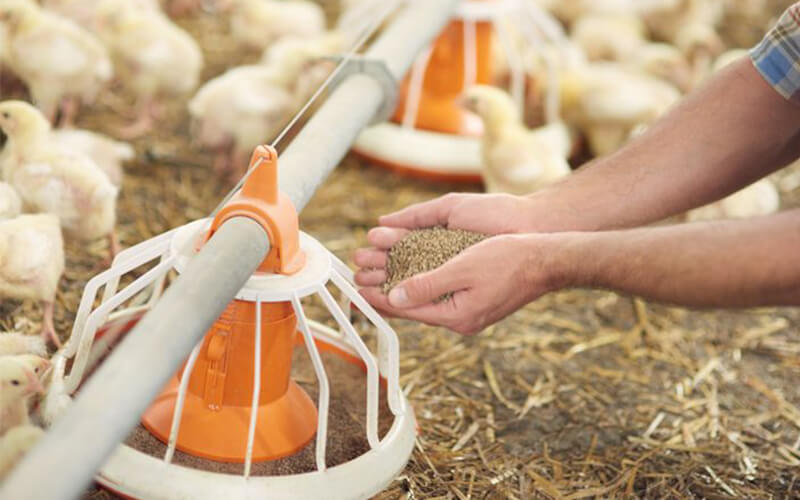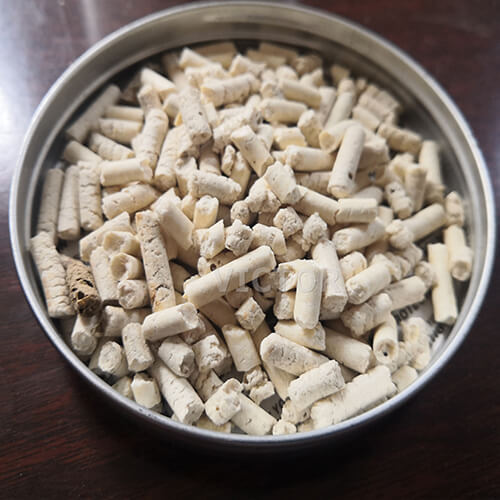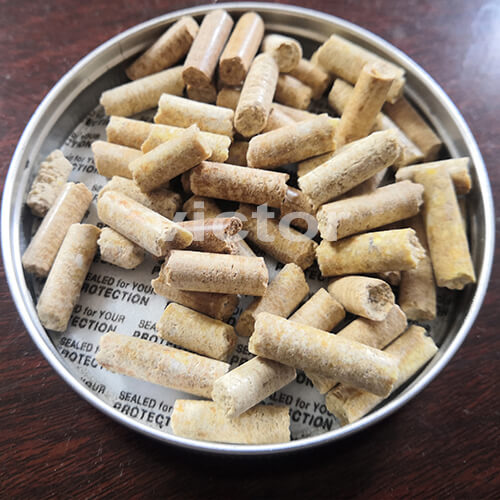5 chicken feed ingredients
Carbohydrate
Carbohydrates are the largest part of the chicken diet in chicken feed ingredients. These are used as quick energy and fuel sources. Common carbohydrates in chicken feed include corn, barley, wheat, and millet.
Mineral
There are two types of minerals for chicken feed ingredients: trace minerals and bulk minerals. Trace minerals include copper, iodine, iron selenium, zinc, etc. Numerous minerals include calcium, phosphorus, potassium and sodium.
Both minerals help with bone formation, muscle and nerve function. Grains often lack the minerals needed for a healthy poultry diet, so supplements can be used. For example, the recipe below contains a nutritional balancer. Alternatively, another excellent source of calcium is freely chosen oyster shells.
Vitamin
Vitamins play an important role in the growth and reproduction of chickens. Some vitamins can be produced by chickens, while others are provided by natural foods and supplements. Chickens need vitamins A, D, E, and K for skin, tissue, bone development, blood coagulation, and egg production. B vitamins like biotin and thiamine are crucial for metabolism.


Protein
Protein is an important part of the chicken feed ingredients as it contributes to the development of the chicken body (muscles, skin, feathers, etc.). Animal-based proteins include fishmeal and meat-and-bone meal.
Vegetable proteins include soybean meal, rapeseed meal, and corn gluten meal.The feed contains more than 20 amino acids. Half of them are essential, including methionine and lysine, which are essential for egg production and overall health.
Poultry feed consists of a variety of plant proteins, such as soybean meal and corn protein, because no single protein can provide all the essential amino acids that chickens need. Sometimes, manufacturers use animal-based proteins such as bone meal and fish meal in their chicken feed. However, the latter tends to produce a fishy odor in poultry and eggs.
Fat
Fats, also known as fatty acids, produce more calories and help chickens absorb fat-soluble vitamins A, D, E and K. Adding fat to chicken feed ingreients can also help with cold winter climates. You can add saturated fats like lard and tallow to a chicken’s diet.
Researchers have confirmed that the fatty acids in chicken food affect egg yolk fatty acids. Humans who eat these eggs have high levels of omega-6 fatty acids that can cause cardiovascular disease, rheumatoid arthritis, and cancer.
chicken feed ingredients formula
Poultry feed,according to wikipedia, is food for farm poultry, including chickens, ducks, geese and other poultry. Before the 20th century, common farms mostly housed poultry that foraged for their feed, consuming insects, grain from cattle and horses, and nearby plants. Farmers usually supplemented this with grains, household waste, calcium supplements like oyster shells, and garden waste.
As farming became more specialized, many farms raised flocks too large to be fed this way, so nutritionally complete poultry feeds were developed. Modern chicken feed ingredients mainly consist of grains, protein supplements (such as soybean oil meal), mineral supplements and vitamin supplements.
The amount of feeds and the nutritional requirements of the feed depend on the weight and age of the birds, their growth rate, egg production, the weather (cold or wet weather results in higher energy expenditure) and the amount of nutrients in chicken feed ingredients the birds get from foraging.
This has resulted in a wide variety of poultry feed formulations. Substituting cheaper local chicken feed ingredients brings additional variation.
2 references of chicken feed formulation
| chicken feed formulation I | chicken feed formulation II |
| 14.5kg of whole maize 24kg of maize germ 19kg of wheat pollard 14.4kg wheat bran 16kg of beniseed meal, groundnut cake, linseed meal, or cotton seed meal. 2.2kg of fishmeal 2.8kg of lime 5kg of soya meal 90g of bone meal 20g of grower premix 30g of salt 10g of coccidiostat 10g of Zinc bacitracin | Maize 44Kg Soybean Full Fat 34Kg Groundnut Cake 2kg Brewer Dry Grain 12Kg Maize Offal 4kg Bone Meal 3Kg Methionine 0.25Kg or 250 grams Lysine 0.25Kg or 250 grams Vitamin/Mineral Premix 0.25kg or 250 grams Salt 0.25Kg or 250 grams |


5 steps of how to make chicken feed
Crushing Process:
Chicken feed crusher is suitable for pulverizing raw materials into powder with optimal particle size to obtain the best granulation effect.
Mixing Process:
Using a chicken feed mixer to make poultry feed pellets ensures a full mix of ingredients, so every pellet bite is nutritionally balanced. If you prefer not to make pellets, you can mix your own chicken feed with the mixing machine after crushing the raw materials.
Pelletizing Process:
Feed pellet machine is the main equipment in making chicken feed pellet. Compared with flat die chicken feed pelletizers, ring die feed making equipment has a larger capacity.
Cooling Process:
Cooling and screening is a crucial step in making your own chicken feed pellets. The granulator discharges granules at up to 88°C with 17-18% moisture. You must quickly lower the pellet temperature to 10-12% moisture or less for proper storage and handling, meaning you need to cool and dry the particles.
Our pellet cooler uses countercurrent cooling to ensure even cooling of the pellets. The temperature of the particles after cooling is not higher than room temperature + 3-5 degrees.
Packing Process:
The packing process is the final step in making chicken feed pellets; after cooling, you can bag or store the pellets as needed. Our semi-automatic packaging machines manage the packaging process efficiently.
A computer weighs the finished feed, which then pneumatically unloads into bags. The weighed bags move down the conveyor belt, and you can use the machine to sew the bag tops for storing the dry feed. these steps of making feeds is like the step of how to make fish feed.
video of how to make chicken feed
what equipment needed for making chicken feed
What equipment do you need in a chicken feed pellet plant? Whether making pellet or powder feed, you need equipment to make chicken feed pellets. With a feed grinder, you can grind fresh grains for chickens.
If you have several birds and don’t want to buy a food grinder, you can use a manual meat grinder. You can use a food processor to finely grind it when making puree or crumble for chicks.
You’ll also want to consider storing the bags of grain you buy. Consider building a storage box for each type of cereal with a lid on it. If you can use the sliding door on the bottom to dispense the beans, you can rotate the beans naturally.
You may need to thoroughly clean the box once or twice a year to prevent pest infestations. When grinding feed, know the time and consistency of the grind. There are three standard terms for commercial feed: feed, chips and pellets. The type of fabric you need depends on the age of the bird.
Mash feed:
Just as young babies are beginning to eat, chicks, with their developing digestive systems and small beaks, also start eating and cannot handle bigger things.
pellet feed:
pellet feed are similar to whole grains; larger and more difficult to digest. This food texture is best maintained until the chicken is at least 18 weeks old.

